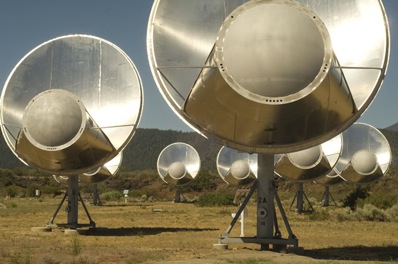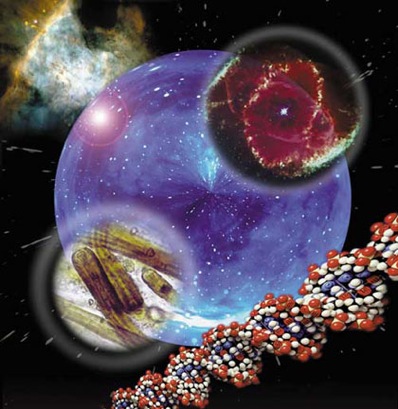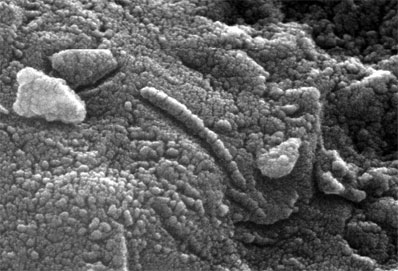



|

|

SETI in the capital – day two
KEITH COOPER REPORTING FROM THE ROYAL SOCIETY
ASTRONOMY NOW
Posted: 27 January 2010


Searching for laser beams from ET, hunting down a second genesis of life on Earth and the broader implications for society upon ET’s discovery were the topics on the menu during the second and final day of The Royal Society’s special meeting on extraterrestrial life.
The active search for extraterrestrial intelligence, as spearheaded by the SETI Institute in California, was fronted at the meeting by Dr Frank Drake, the ‘godfather’ of SETI. In 1960 he kicked things off by conducting a radio search of two stars, epsilon Eridani and tau Ceti, and ever since the search has snowballed with radio telescopes all across the world surveying millions of stars for that elusive message from the heavens.
 The Allen Telescope Array is a joint project between the SETI Institute and the University of California, Berkeley, and is expected to speed up SETI targeted searching by a factor of at least 100. The Allen Telescope Array is a joint project between the SETI Institute and the University of California, Berkeley, and is expected to speed up SETI targeted searching by a factor of at least 100.
One way that ET may be broadcasting to the Universe at large is via a beacon that won’t beam a message in all directions at once, but would fire a signal at us for a short while before moving onto the next star system in a cycle that would eventually see the beacon come back to us. How long the period of this cycle would be is unknown, which makes detecting such signals more difficult. That’s because to verify a signal from ET, it must be seen to repeat, but our search procedures are not set up to stay on one part of the sky for very long. According to Drake, this is all down to it being two expensive to devote a long stretch of telescope time to one part of the sky on the off chance that a signal will repeat months or years down the road. This is the reason why we haven’t been able to follow up on the famous ‘Wow’ signal of 1977 as we would have liked to.
However, another method by which altruistic aliens may reach out to us is through laser light. The most powerful laser on Earth at the National Ignition Facility at the Lawrence Livermore National Laboratory in the USA can reach an astonishing 1015 watts for a billionth of a second. A large amount of information can be encoded into laser light, and such a powerful laser could reach across the cosmos. “The flash of light would be brighter than a star across all optical wavelengths,” says Drake. “For a billionth of a second a laser flash would make a star a thousand times brighter – it seems like a good way to signal to one another.” Already there are devices designed to detect these extremely brief flashes but so far they have not found anything.
 Could the ingredients for life exist elsewhere in the Universe? Image: NASA/JPL Could the ingredients for life exist elsewhere in the Universe? Image: NASA/JPL
It would help if we had an idea of how many civilisations are out there that could potentially be signalling us. This is where the Drake Equation comes in, but so many of the factors in this famous formula are complete unknowns, including on how many Earth-like planets life arises. We already know of one such planet where this has happened – Earth. But how many times has it happened here? That’s the question that Professor Paul Davies of the University of Arizona asked in his presentation, ‘Searching for a Shadow Biosphere on Earth’. If it could be shown that there was a second genesis of life on Earth, independent of our own tree of life, perhaps with its own biochemical rules, it would make us more confident that life is not a fluke, but happens whenever conditions permit – a kind of ‘cosmic imperative’ according to Nobel Prize winning biochemist Professor Christian de Duve.
“The origin and development of life were largely ruled by the physical and chemical conditions of the time,” de Duve said in his presentation on the matter. “These conditions had a determining role on life’s chemistry, and selective optimisation was imposed by the prevailing chemical and physical conditions. So life is a cosmic imperative so long as these conditions are not unique to Earth.”
 Perhaps the closest we've been to discovering evidence for life outside of Earth is the fossil-like features seen in Martian meteorites. Image: NASA. Perhaps the closest we've been to discovering evidence for life outside of Earth is the fossil-like features seen in Martian meteorites. Image: NASA.
If life were to be discovered beyond Earth, how would it change society? Professor Iván Almár of the Hungarian Academy of Sciences has designed the ‘London scale’ for astrobiology, a little bit like the Richter scale for earthquakes or the Torino scale for asteroid impacts. This would come into effect to help explain to the public the relevance of a discovery such as potential microbial fossils in a meteorite from Mars or the remote detection of life on another planet. Would this be sufficient to calm and educate the public regarding a momentous announcement about SETI? Professor Albert Harrison of the University of California, Davis, argued that all the evidence points to the public’s reaction to the discovery of life elsewhere being “underwhelming” (depending on the context in which it is found, of course) while Professor Ted Peters of the Pacific Lutheran Theological Seminary, USA, argued that religion would not be affected by the discovery, though perhaps the audience was not entirely convinced on this matter. Meanwhile Dr Kathryn Denning of York University in Toronto, Canada, warned of placing too much trust in using first contact stories from humanity’s own history as examples on which to base our expectations of first contact with ET. History can easily be warped into myth and fiction, and indeed a similar fate could await the story of contact with ET if we are not careful.
The Royal Society meeting was a coming together of some great minds on a topic that will hopefully take more importance in the coming decades, but the fascinating discussions showed that we still have some way to go before astrobiology and SETI can fully mature. That journey, however, promises to take us to into realms of life, both terrestrial and extraterrestrial, that we could only have dreamt of.
|

|

|

|
|



